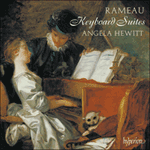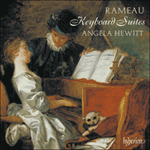
Welcome to Hyperion Records, a British classical label devoted to presenting high-quality recordings of music of all styles and from all periods from the twelfth century to the twenty-first.
Hyperion offers both CDs, and downloads in a number of formats. The site is also available in several languages.
Please use the dropdown buttons to set your preferred options, or use the checkbox to accept the defaults.

| Angela Hewitt (piano)» More |

Like the 1724 volume, this collection also contains two suites. The Suite in A minor opens with a stirring Allemande, a tribute to the good old style. But even here one can hear that special Ramellian wink in the chains of thirds and sixths in the accompanying voices. Once engaged in such flowery discourse Rameau cannot help himself, and he even adds codas with chains of triplets to the cadences in each half. The overall effect is one of noble vocality with a slight tinge of resignation. The quality of grandeur is further underlined in the Courante, in which the running quavers juxtaposed with the sharp rhythms and accents of the original dance surely mean to evoke a blend of French orchestral practice and the art of Italian violin-playing.
The graceful movements of the Sarabande show Rameau as the king of the dance, as he skilfully portrays the elaborate gestures of the dancer with specific indications for the arpeggiation and decoration of chords. It is as if the harpsichordist’s fingers themselves become dancers, maintaining the grand gestures of the feet in balance with the fanciful movements of the dancer’s hands, as was the practice in performing sarabandes. Les trois mains is a bit of a mystery. Is it simply a cheeky depiction of three greatly independent parts on the keyboard? Or can we detect the influence of Domenico Scarlatti, who had visited Paris in 1724? Then there is the term ‘three hands’ used in dancing, specifically in the Scottish strathspey ‘Nora’s Fandango’.
Fanfarinette and La triomphante illustrate Rameau’s mastery of the pièce de caractère. The first is a depiction of someone who feigns bravery (the term is derived from ‘fanfaron’—a braggart); perhaps we can hear this in the fanciful quality of the melody and the runs in the right hand. The second piece is a general evocation of triumph rather than a reference to a specific person; the last couplet has a hint of Rameau the curmudgeon. The A minor Suite closes with the justifiably famous Gavotte with six ‘doubles’, or variations, which has become a warhorse of many a recital programme. The solid, chorale-variation flavour to this piece makes sense when we hear it through the lens of Handel’s eight ‘great’ suites of 1720, a hugely popular collection that appears in bits and pieces in Continental sources and which was certainly known to Rameau. Rameau’s variations are directly based, in fact, on the air and variations from Handel’s D minor Suite. And Handel’s variations are, in turn, elaborations on models by Pachelbel and Zachow. Rameau seems to have been blissfully ignorant of the Germanic and ecclesiastical basis of such a variation style, and in the final three variations he takes a completely different and frankly virtuosic path.
from notes by Mahan Esfahani © 2014
Comme le volume de 1724, ce recueil contient également deux suites. La Suite en la mineur débute par une Allemande enthousiasmante, hommage au bon vieux style. Mais, même là, on peut percevoir ce clin d’œil typique de Rameau dans les séries de tierces et de sixtes des voix accompagnatrices. Une fois engagé dans un discours aussi fleuri, Rameau ne peut s’en empêcher et, à chaque moitié, il ajoute même aux cadences des codas avec des séries de triolets. L’effet d’ensemble est une noble vocalité et une légère teinte de résignation. La grandeur est encore soulignée dans la Courante, où les croches galopantes juxtaposées aux rythmes vifs et aux accents de la danse originale veulent sûrement évoquer un mélange de pratique orchestrale française et de l’art du violon italien.
Les mouvements gracieux de la Sarabande montrent Rameau comme le roi de la danse lorsqu’il dépeint habilement les gestes élaborés du danseur avec des indications spécifiques pour la manière d’arpéger et de décorer les accords. On a l’impression que les doigts du claveciniste deviennent eux-mêmes des danseurs, maintenant les gestes spectaculaires des pieds en équilibre avec les mouvements fantaisistes des mains du danseur, comme c’était l’usage lorsqu’on jouait les sarabandes. Les trois mains constituent une sorte de mystère. S’agit-il simplement d’une représentation espiègle de trois parties très indépendantes au clavier? Ou peut-on déceler l’influence de Domenico Scarlatti, qui s’était rendu à Paris en 1724? Et le terme «trois mains» est utilisé dans la danse, spécifiquement dans le strathspey écossais «Fandango de Nora».
Fanfarinette et La triomphante illustrent la maîtrise de Rameau dans le domaine des pièces de caractère. La première dépeint quelqu’un qui simule la bravoure (le titre est dérivé du mot fanfaron); on peut sans doute le percevoir dans le côté fantasque de la mélodie et les traits à la main droite. La seconde pièce est une évocation générale du triomphe plus qu’une référence à une personne spécifique; le dernier couplet a une touche de Rameau le grincheux. La Suite en la mineur s’achève sur la Gavotte avec six «doubles» ou variations, célèbre à juste titre, qui est devenue un cheval de bataille dans de nombreux programmes de récitals. Cette atmosphère solide de choral varié a un sens lorsqu’on l’écoute en se référant aux huit «grandes» suites de Haendel de 1720, recueil extrêmement populaire qui fut publié en morceaux séparés dans des sources européennes continentales et qui était certainement connu de Rameau. En fait, les variations de Rameau reposent directement sur l’air et variations de la Suite en ré mineur de Haendel. Et les variations de Haendel sont, à leur tour, des élaborations sur des modèles de Pachelbel et Zachow. Il semble que Rameau ait totalement ignoré la base germanique et ecclésiastique d’un tel style de variations et, dans les trois dernières variations, il suit une voie complètement différente et résolument virtuose.
extrait des notes rédigées par Mahan Esfahani © 2014
Français: Marie-Stella Pâris
Wie der Band von 1724 enthält auch dieser zwei Suiten. Die Suite in a-Moll beginnt mit einer mitreißenden Allemande, ein Tribut an den guten alten Stil. Doch selbst hier ist jenes besondere Rameausche Zwinkern in den Terzen- und Sextenketten der Begleitstimmen zu hören. Einmal mit einem so blumigen Diskurs befaßt, kann Rameau nicht umhin, den Kadenzen in jeder Hälfte sogar noch Codas mit Triolenketten anzuhängen. So ergibt sich insgesamt ein nobler Wohlklang mit einem Hauch von Resignation. Die Grandeur wird auch in der Courante betont, in der die fortlaufenden Achtel neben den kantigen Rhythmen und Akzenten des ursprünglichen Tanzes sicherlich eine Mischung aus französischer Orchesterpraxis und der Kunst des italienischen Violinspiels evozieren sollen.
In den graziösen Sätzen der Sarabande erweist sich Rameau als König des Tanzes, wenn er die kunstvollen Bewegungen des Tänzers mit speziellen Angaben zum Arpeggieren und Verzieren der Akkorde gekonnt wiedergibt. Die Finger des Cembalisten scheinen selbst zu Tänzern zu werden, indem sie die kunstvollen Bewegungen der Füße mit den ausgefeilten Bewegungen der Hände des Tänzers koordinieren, wie es auch bei der Ausführung von Sarabanden praktiziert wurde. Les trois mains ist ein wenig rätselhaft. Ist es einfach die vorwitzige Schilderung dreier großenteils unabhängigerStimmen auf der Tastatur? Oder läßt sich hier der Einfluß von Domenico Scarlatti ausmachen, der 1724 nach Paris gekommen war? Und dann gibt es noch die Angabe „drei Hände“, die bei Tänzen verwendet wurde, besonders bei dem schottischen Strathspey „Nora’s Fandango“.
Fanfarinette und La triomphante illustrieren Rameaus Meisterschaft im pièce de caractère. Das erste ist die Schilderung einer Person, die Tapferkeit vortäuscht (der Begriff ist von „fanfaron“, ein Maulheld, abgeleitet); das kann man vielleicht in der fantastischen Melodie und den Läufen in der rechten Hand hören. Das zweite Stück evoziert eher allgemein Triumph, als auf eine bestimmte Person zu verweisen; im letzten Couplet gibt es einen Anklang an Rameau, den Griesgram. Die a-Moll-Suite endet mit der zu Recht berühmten Gavotte mit sechs „doubles“ (oder Variationen), die zu einem Bravourstück in vielen Recitalprogrammen geworden ist. Der ausgeprägte Charakter einer Choralvariation in diesem Stück erscheint logisch, wenn man es mit Händels acht „großen“ Suiten von 1720 im Ohr hört, einer immens beliebten Sammlung, die einzeln in europäischen Quellen erschienen ist und die Rameau sicher kannte. Seine Variationen beruhen tatsächlich unmittelbar auf dem Air mit Variationen aus Händels d-Moll-Suite. Und Händels Variationen sind ihrerseits Ausarbeitungen von Vorbildern bei Pachelbel und Zachow. Rameau war wohl in glücklicher Unkenntnis der deutschen und der kirchlichen Grundlagen eines derartigen Variationsstiles; mit den letzten drei Variationen beschreitet er gänzlich andere und unverblümt virtuose Wege.
aus dem Begleittext von Mahan Esfahani © 2014
Deutsch: Christiane Frobenius
 Rameau: Keyboard Suites Rameau: Keyboard SuitesJean-Philippe Rameau started his career in an unusual manner, a provincial organist who rarely served out his contract (and on one occasion deliberately played sufficiently badly to ensure his dismissal). By 1745, however, he had risen to be ‘Comp ...» More |
 Bach: Goldberg Variations - Vinyl Edition Bach: Goldberg Variations - Vinyl EditionAngela Hewitt has chosen this album from her glorious Bach discography as the first to be available on vinyl. Recorded in 2015, this is a ‘Goldberg’ to savour and here as a bonus Side 4 includes a magnificent suite of dances by Rameau.» More |
 Rameau: Keyboard Suites Rameau: Keyboard Suites |

